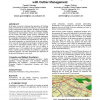GISCIENCE
2004
Springer
14 years 5 months ago
2004
Springer
Abstract. A datatype with increasing importance in GIS is what we call the location history–a record of an entity’s location in geographical space over an interval of time. Thi...
GISCIENCE
2004
Springer
14 years 5 months ago
2004
Springer
Abstract. Integration of GIS and hydrologic models has been a common approach for monitoring our ever-changing hydrologic system. One important issue in adapting such an approach i...
GISCIENCE
2004
Springer
14 years 5 months ago
2004
Springer
In geospatial applications with heterogeneous databases, an ontology-driven approach to data integration relies on the alignment of the concepts of a global ontology that describe ...
GIS
2007
ACM
14 years 6 months ago
2007
ACM
As technology advances we encounter more available data on moving objects, thus increasing our ability to mine spatiotemporal data. We can use this data for learning moving object...
GIS
2007
ACM
14 years 6 months ago
2007
ACM
In this paper, we present a technique that generalizes 3D building groups of virtual 3D city models according to a cell structure that is derived from infrastructure networks. In ...
AGILE
2009
Springer
14 years 6 months ago
2009
Springer
AGILE
2009
Springer
14 years 6 months ago
2009
Springer
The problem of line simplification is a recurrent problem in cartography. The purpose is to remove irrelevant details while emphasising the main features of the line. Most of the ...
AGILE
2009
Springer
2009
Springer
Enhancing 3D City Models with Heterogeneous Spatial Information: Towards 3D Land Information Systems
14 years 6 months ago
Spatial and georeferenced information plays an important role in urban land management processes such as spatial planning and environmental management. As many of the processes ar...
AGILE
2009
Springer
14 years 6 months ago
2009
Springer
Image retrieval of landscape photographs requires accurate annotation using multi-faceted descriptions relating to the subject and content of the photograph. The subject of such ph...
AGILE
2009
Springer
2009
Springer
Three-Valued 9-Intersection for Deriving Possible Topological Relations from Incomplete Observations
14 years 6 months ago
Topological relations, which concern how two objects intersect, are one of the most fundamental and well-studied spatial relations. Typically, topological relations are distinguis...



